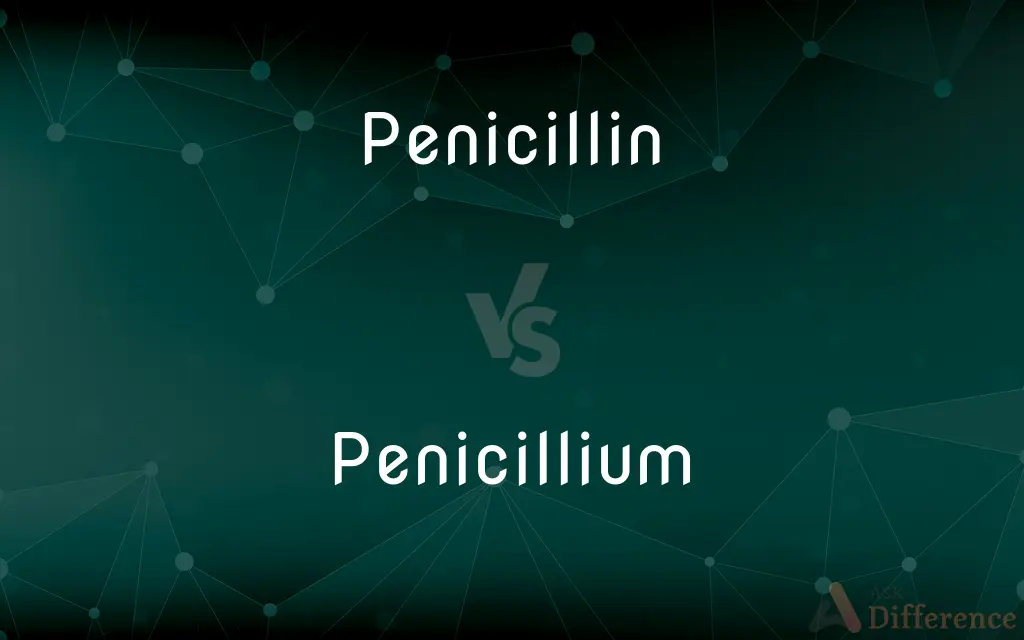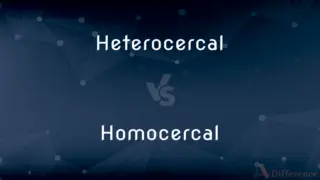Penicillin vs. Penicillium — What's the Difference?
By Maham Liaqat & Fiza Rafique — Updated on April 7, 2024
Penicillin is an antibiotic derived from the Penicillium mold; Penicillium is a genus of mold that produces penicillin.

Difference Between Penicillin and Penicillium
Table of Contents
ADVERTISEMENT
Key Differences
Penicillin and Penicillium are closely related yet distinct entities within the field of microbiology and pharmaceuticals. Penicillin refers to a group of antibiotics that are derived from the molds of the Penicillium genus. These antibiotics were the first to be used widely and have saved countless lives by treating bacterial infections effectively. Penicillium, on the other hand, is the genus of the mold itself, which includes several species that can produce the antibiotic penicillin under the right conditions.
Penicillin works by inhibiting the synthesis of bacterial cell walls, leading to the destruction of bacteria. It has been a cornerstone in the treatment of bacterial infections since its discovery. The discovery of penicillin is attributed to Alexander Fleming in 1928, marking a revolution in medical history. Meanwhile, Penicillium molds are not only significant for their medicinal contributions but are also used in the production of certain cheeses, where they add flavor and texture.
The production of penicillin involves cultivating Penicillium mold under controlled conditions to maximize the production of the antibiotic. This process is a fascinating example of how a naturally occurring organism can be harnessed for a significant medical purpose. Penicillium species, such as Penicillium chrysogenum, are specially grown to produce penicillin in large quantities for pharmaceutical use.
While penicillin has been a miraculous drug, saving millions of lives, it is not without its challenges. Some individuals are allergic to penicillin, and overuse has led to the development of antibiotic-resistant strains of bacteria. Meanwhile, the Penicillium genus is vast and diverse, with species having a range of effects on human life, from beneficial to harmful.
In essence, penicillin and Penicillium serve as a prime example of the intersection between nature and medicine, illustrating how natural substances can be transformed into lifesaving drugs. The story of penicillin's discovery and its relationship with the Penicillium mold is a testament to the importance of scientific curiosity and innovation in the advancement of healthcare.
ADVERTISEMENT
Comparison Chart
Definition
A group of antibiotics derived from Penicillium mold.
A genus of mold that includes species producing penicillin.
Discovery
Discovered by Alexander Fleming in 1928.
Known before penicillin, used in food and medicine.
Uses
Treats bacterial infections by inhibiting cell wall synthesis.
Used in cheese production and as a source of antibiotics.
Production
Cultivated from Penicillium mold under controlled conditions.
Grown for its ability to produce antibiotics and for food industry use.
Challenges
Allergies and antibiotic resistance.
Mold contamination and mycotoxin production in some species.
Compare with Definitions
Penicillin
Bacterial infection treatment.
Penicillin treats various bacterial infections effectively.
Penicillium
Natural occurrence.
Penicillium molds are commonly found in nature, on food, and in indoor environments.
Penicillin
Derived from mold.
Penicillin is produced using the Penicillium mold.
Penicillium
Mold genus.
The Penicillium genus includes many species that are useful in medicine and food.
Penicillin
Antibiotic substance.
Penicillin has saved millions of lives since its introduction.
Penicillium
Diverse species.
The Penicillium genus includes species with various effects on human health and industry.
Penicillin
Cell wall synthesis inhibitor.
Penicillin works by preventing bacteria from building their cell walls.
Penicillium
Antibiotic source.
Some Penicillium species produce the antibiotic penicillin.
Penicillin
Subject to resistance.
Overuse of penicillin has led to the development of resistant bacterial strains.
Penicillium
Used in cheese making.
Penicillium roqueforti is used to make blue cheese.
Penicillin
Penicillins (P, PCN or PEN) are a group of antibiotics originally obtained from Penicillium moulds, principally P. chrysogenum and P. rubens. Most penicillins in clinical use are chemically synthesised from naturally-produced penicillins.
Penicillium
Penicillium () is a genus of ascomycetous fungi that is part of the mycobiome of many species and is of major importance in the natural environment, in food spoilage, and in food and drug production. Some members of the genus produce penicillin, a molecule that is used as an antibiotic, which kills or stops the growth of certain kinds of bacteria.
Penicillin
An antibiotic drug obtained from molds especially of the genus Penicillium or produced synthetically, available in various preparations and usually used to treat infections caused by gram-positive bacteria.
Penicillium
Any of various characteristically bluish-green fungi of the genus Penicillium that grow as molds on decaying fruits and ripening cheese and are used in the production of antibiotics such as penicillin and in making cheese.
Penicillin
Any of a group of broad-spectrum antibiotic drugs, synthetic or semisynthetic, that are derived from penicillin.
Penicillium
Any of the blue-green fungi, of the genus Penicillium, that are used in the manufacture of cheeses, and are an important source of antibiotics.
Penicillin
(pharmaceutical drug) Any of a group of narrow-spectrum antibiotics obtained from Penicillium molds or synthesized, that have a beta-lactam structure and are active against gram-positive bacteria and used in the treatment of various infections and diseases.
Penicillium
Genus of fungi commonly growing as green or blue molds on decaying food; used in making cheese and as a source of penicillin
Penicillin
(mycology) A blue mold of the genus Penicillium that produces penicillin.
Penicillin
Any of a variety of substances having a structure containing a beta-lactam ring fused to a thiirane ring, to which a carboxyl group is attached, but most commonly interpreted as benzyl penicillin. They are notable as powerful antibacterial agents of relatively low toxicity which have found extensive use in medicine for treating bacterial infections. They are categorized as one of the classes of beta-lactam antibiotic. They are produced naturally by some fungi and bacteria, and industrial production processes almost invariably start from some form of the penicillin nucleus produced by fermentation of microorganisms. The fermentation products are then chemically modified to produce derivatives of enhanced potency, safety, or antibacterial spectrum. The first penicillin to see extensive use clinically (during World War II) was penicillin G, also called benzypenicillin, and commonly simply "penicillin".
Penicillin
Any of various antibiotics obtained from penicillium molds (or produced synthetically) and used in the treatment of various infections and diseases
Common Curiosities
Can all Penicillium species produce Penicillin?
No, only specific species of Penicillium are known to produce penicillin.
How was Penicillin discovered?
Alexander Fleming discovered penicillin in 1928 when he noticed that Penicillium mold inhibited bacterial growth.
What are some uses of Penicillium besides antibiotic production?
Penicillium is used in the food industry, notably in the production of blue cheeses.
Why is Penicillin important in medicine?
Penicillin marked the beginning of the antibiotic era, drastically reducing deaths from bacterial infections.
Is Penicillin still used today?
Yes, penicillin and its derivatives remain crucial for treating various bacterial infections.
What is the relationship between Penicillin and Penicillium?
Penicillin is an antibiotic derived from certain species of Penicillium mold.
What challenges are associated with Penicillin use?
Challenges include allergic reactions in some people and the development of antibiotic-resistant bacteria.
How are Penicillin and its derivatives produced?
They are produced through the fermentation of Penicillium mold in controlled environments.
What is the significance of Penicillium in food?
Beyond antibiotics, Penicillium species contribute to the flavor and texture of certain cheeses.
What are some common misconceptions about Penicillin and Penicillium?
A common misconception is that all molds, including all Penicillium species, are harmful, whereas some have beneficial uses in medicine and food.
Share Your Discovery

Previous Comparison
Governess vs. Mistress
Next Comparison
Heterocercal vs. HomocercalAuthor Spotlight
Written by
Maham LiaqatCo-written by
Fiza RafiqueFiza Rafique is a skilled content writer at AskDifference.com, where she meticulously refines and enhances written pieces. Drawing from her vast editorial expertise, Fiza ensures clarity, accuracy, and precision in every article. Passionate about language, she continually seeks to elevate the quality of content for readers worldwide.














































